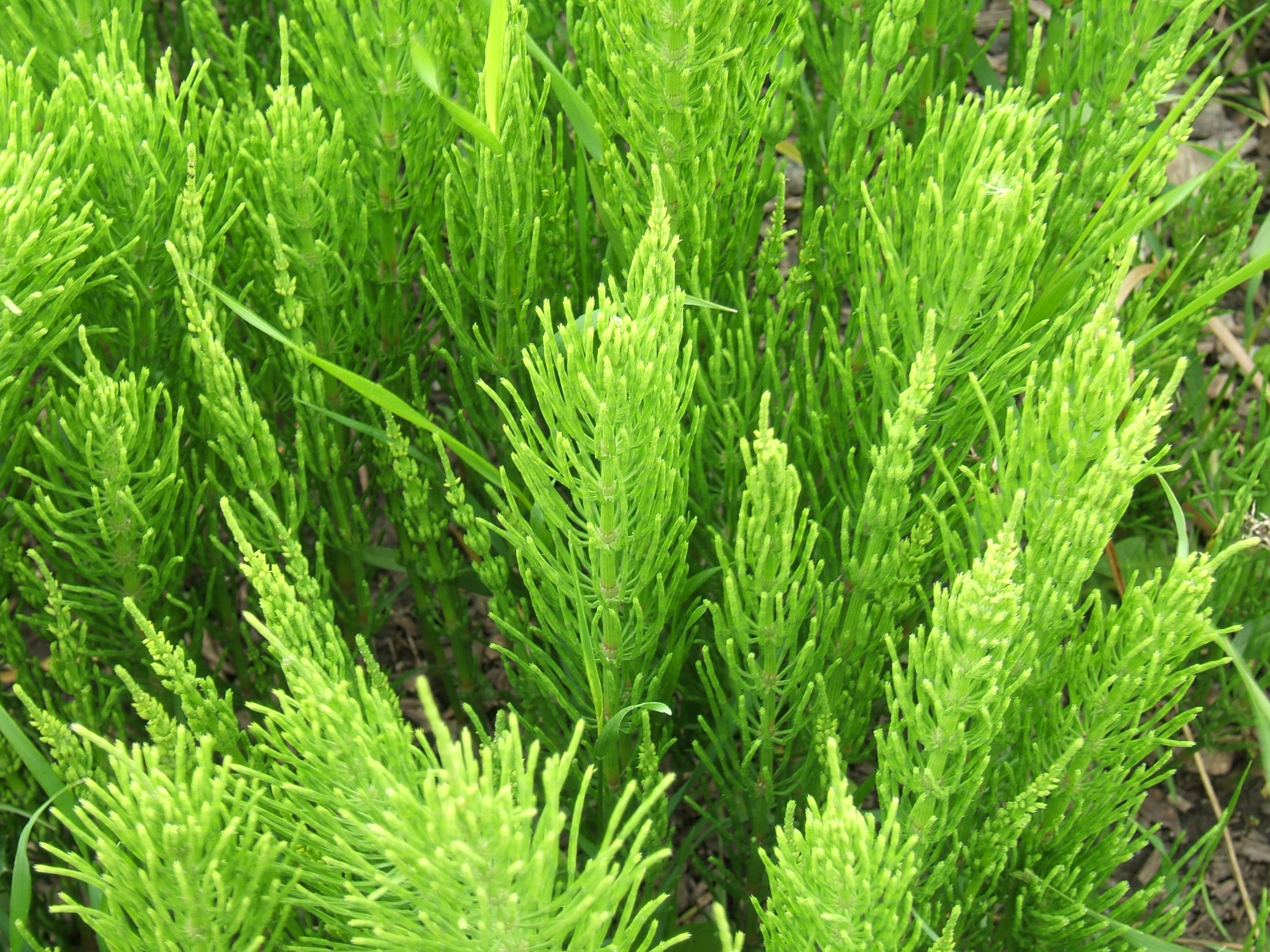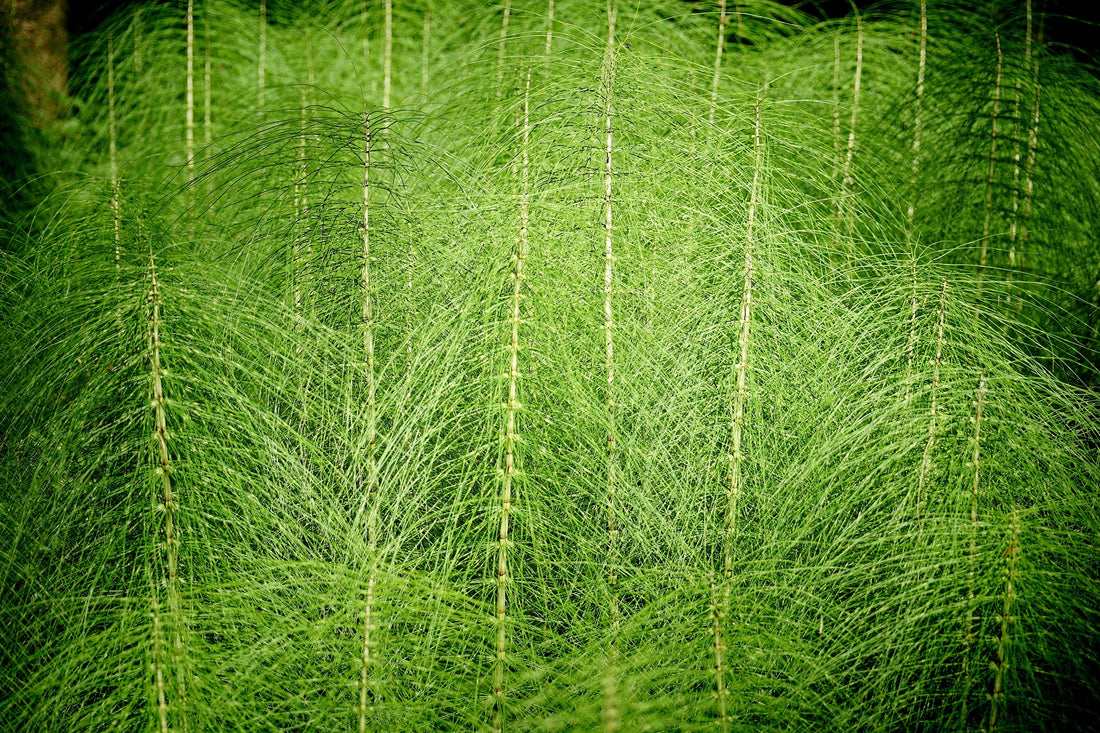Everything you always wanted to know about this obnoxious weed (but were afraid to ask).
Horsetail (Equisetum sp.), also commonly known as mare’s tail, is a prehistoric, herbaceous, perennial plant that has become a source of frustration for modern farmers due to its tenacious and stubborn characteristics as a weed. The coastal region of British Columbia is home to several species, the most common of which are listed here:
Equisetum arvense - Common Horsetail or Field Horsetail: This is one of the most widespread horsetail species and can be found in various habitats, including moist soils, meadows, and along water bodies. It has a stem with distinct tightly spaced jointed segments and many thin branches. The plant is bright green and typically grows up to 30cm tall.

(Image source: © Wikimedia Commons User: MPF / CC-BY-SA-3.0)
Equisetum hyemale - Rough Horsetail or Scouring Rush (image 2): This horsetail species is known for its abrasive silica deposits in its stem, giving it a noticeable gritty feel to the touch. It typically grows in wetlands and along water bodies. It has dark green non-branching stems with 14-50 ridges, that unlike other species of horsetail, persist through the winter months. (Source: © Flickr.com hebdromadaires: MPF / CC-BY-SA-2.0)
Equisetum palustre - Marsh Horsetail (image 5): Marsh horsetail is typically found in wetlands and marshy areas. It has a rough and furrowed stem and upward reaching thin branches. (Image Source: © Wikimedia Commons User: Kristian Peters / CC-BY-SA-3.0)
Equisetum variegatum - Variegated Horsetail (image 6): This species is recognized by its distinctive variegated appearance, with alternating dark and light bands on the stem. Like rough horsetail, it is not branching and persists through the winter. The stem has 3-12 ridges, and a ring of larger and fewer distinct teeth (leaves) around the base of each stem segment, which help differentiate this species from E. laevigatum and E. hyemale. It is typically found in wet or moist habitats. (Image Source: © Wikimedia Commons User: Jon /CC BY-SA 4.0 DEED)
Equisetum laevigatum - Smooth Scouring Rush (image 7): This horsetail species is known for its relatively smooth stem, lacking the rough texture of some other species and usually without branching. It can be differentiated from E. hyemale by its black teeth with white margins, although they fall off as the season progresses. A dark ring around the top of the sheath will remain to aid in identification. It prefers moist habitats and may be found along water bodies. (Image Source: © Wikimedia Commons User: Walter Siegmund /CC BY-SA 4.0 DEED)

Which species of horsetail invaded your field?
Determining the species of horsetail (Equisetum) growing in your field can be a bit challenging, as there are several species that can be found in the region, and they often share similar characteristics. However, you can follow these steps to help identify the species of horsetail in your field:
- Observe the Habitat: Take note of the specific habitat in which the weed is growing. Different species may prefer different environments, such as wetlands, woodlands, or disturbed areas.
- Examine the Stem: Carefully examine the stem of the horsetail. Horsetail stems are typically jointed and segmented, resembling bamboo. Note the color, size, and texture of the stem. Some species may have rough textures, while others may be smoother.
- Check for Branching: Look for branches or "whorls" of branches that emerge from the main stem. Some species have branching patterns, while others have a single, unbranched stem.
- Look for Leaf-Like Structures: While horsetail weeds are not known for their leaves, some species may have tiny, scale-like leaves at the base of the stem or whorls of leaves at branching points. Check for any leaf-like structures and their arrangement.
- Inspect the Spore-Producing Structures: Horsetail weeds produce spores in cone-like structures called strobili at the tips of their stems. Examine the strobili and note their size, shape, and location on the plant.
- Consult Field Guides and Resources: Utilize field guides, plant identification books, or online resources specific to the region. Local botanical or agricultural associations may also provide resources and assistance.
- Use Plant Identification Apps: There are several mobile apps available that can assist in plant identification. You can take a photo of the horsetail and use the app to help identify the species. Examples include iNaturalist, PlantSnap, and PictureThis.
- Seek Expert Advice: If you are uncertain about the identification, consider reaching out to a local botanist, horticulturist, or agricultural extension agent who specializes in weed identification. They may be able to provide more specific guidance and may even conduct a site visit.
- Collect a Sample: As a last resort, you can collect a small sample of the horsetail, including leaves, stems, and reproductive structures. Store the sample in a plastic bag and take it to a local plant expert for identification.
How does it spread?
Horsetail is known for its ability to spread quickly and persistently. It has several mechanisms that contribute to its rapid spread:
- Rhizomes: Horsetail plants often spread through underground rhizomes. Rhizomes are underground stems that can give rise to new shoots and plants. They can grow horizontally and produce new shoots at various points, allowing horsetail to expand rapidly. Vertically, they can grow up to 3 m deep into the soil. This makes it difficult to control since even a small piece of rhizome left in the soil can regrow into a new plant.
- Spore Production: Horsetail reproduces not only through vegetative means (rhizomes) but also by producing spores. These spores are released into the air and can be carried by the wind to new areas, allowing horsetail to colonize distant locations. Spores can also be spread by water, making water bodies a common means of dispersal.
- Tough Plant Structure: Horsetail plants have a tough and hardy structure, with a high content of silica. This makes them resistant to many herbicides and difficult to remove by mechanical means. Their segmented stems and branches can easily break apart, further aiding their spread as these fragments can take root and grow into new plants.
- Adaptation to Various Habitats: Horsetail is adaptable to a wide range of environmental conditions, including wetlands, ditches, disturbed areas, and gardens. Its ability to thrive in different habitats makes it a highly successful and invasive plant.
- Lack of Natural Predators: Horsetail is not a preferred food source for many herbivores due to its high silica content and unpalatable taste. This lack of natural predators allows it to grow unchecked in many environments.
- Longevity: Horsetail plants can live for several years and continue to produce spores and rhizomes during their lifespan. This long-lived nature allows them to establish and persist in an area for an extended period.
- Resilience to Environmental Stress: Horsetail has evolved to withstand various environmental stressors, including drought, flooding, and poor soil conditions. Its ability to adapt and survive under adverse conditions helps it spread rapidly in different landscapes.
Due to these multiple mechanisms of reproduction, adaptation, and resilience, horsetail can spread quickly and become a persistent problem in gardens, agricultural fields, and natural landscapes. Effective management often involves a combination of cultural, mechanical, and chemical control methods, but it can be challenging to eradicate completely due to its tenacious growth habits.
How to control it in your fields
Horsetail is one of the hardest weeds for any crop producer to manage. The stems grow in groups that are connected by one massive, creeping, tuber-bearing root system, called a rhizome, which can permeate deeply into the soil. Cultivating chops the rhizomes into small pieces, each of which can regenerate into a new plant. Furthermore, the thin and waxy branches of horsetail provide poor adherence for herbicides, compounding the difficulty of control. Spread can be prevented by cutting back the reproductive cone in early spring, being careful not to spread spores by storing it in a sealed plastic bag for disposal. Vegetative stems can be cut back throughout the season to prevent photosynthesis. In addition to implementing cultural preventative measures, growers can turn to herbicides as an option to combat this persistent weed. Consult with local experts, production guides, or crop advisors for recommendations on herbicides registered on horsetail for your crop.
(NOTE: Always read the label for crop-specific instructions and follow instructions. Not all herbicides will be registered for your crop)
As always, do not hesitate to contact us to find out more about your option to control horsetail in your field.
Here is a general guideline for herbicide application timing based on the typical life cycle stages of these horsetail species. Keep in mind that actual timing may vary, and it is essential for growers to monitor local conditions closely.
Basic Herbicide Application Calendar
|
Life Cycle Stage |
Timing for Herbicide Application (Approximate) |
|
Spore Germination |
Early spring (March - April) |
|
Gametophyte Development |
Late spring to early summer (April - June) |
|
Sexual Reproduction |
After significant rainfall events |
|
Zygote Development |
Late spring to early summer (April - June) |
|
Sporophyte Growth |
Late spring to early fall (April - September) |
|
Vegetative Reproduction |
Ongoing throughout the year |
|
Sporangia Formation |
Late summer to early fall (August - September) |
|
Spore Formation and Release |
Late summer to early fall (August - September) |
|
Winter Dormancy |
Late fall to early spring (October - February) |
Written by Ellie Stewart, Technical Sales Representative at TerraLink

